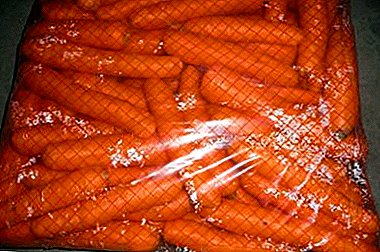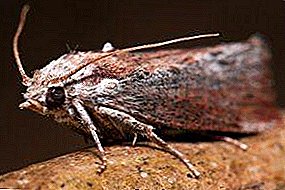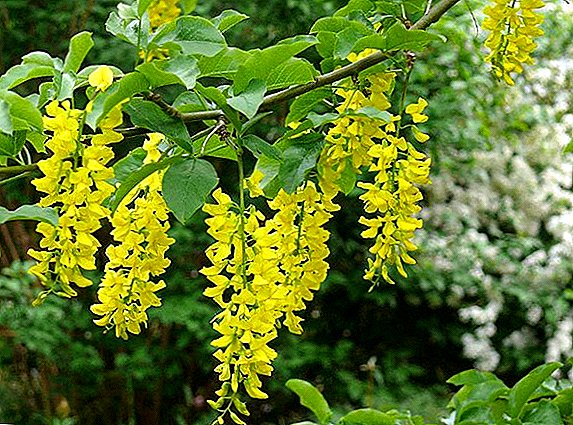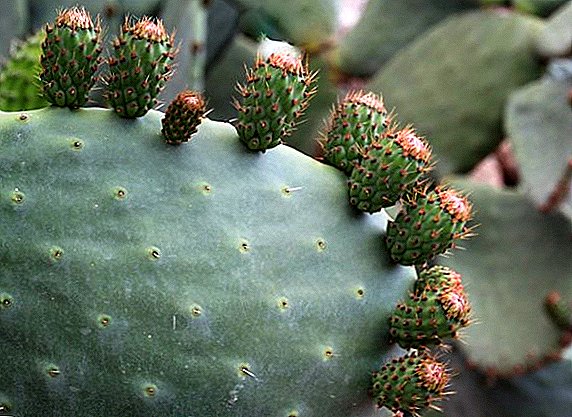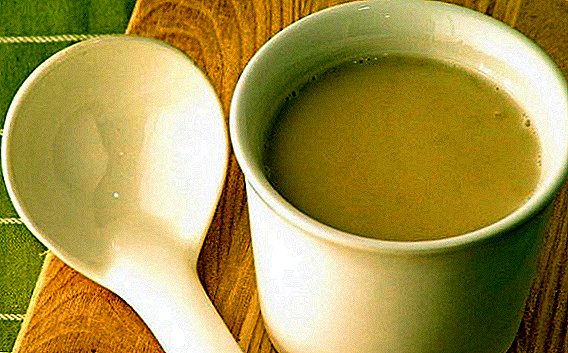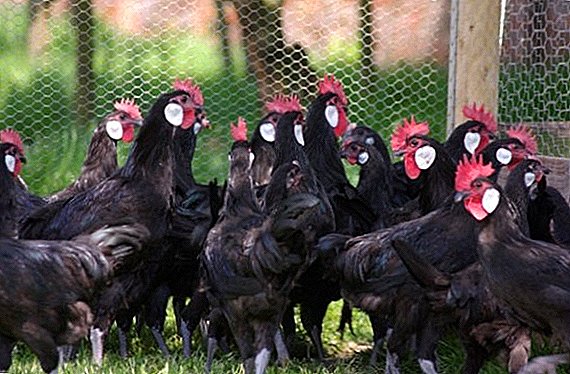 Minorca chickens are European beauties who have been recognized for their spectacular appearance, as well as for very tasty meat and eggs. What is the peculiarity of these layers and the advantages of how to breed them at home, we consider next.
Minorca chickens are European beauties who have been recognized for their spectacular appearance, as well as for very tasty meat and eggs. What is the peculiarity of these layers and the advantages of how to breed them at home, we consider next.
History reference
The name of the Minorca breed comes from the Spanish island of the same name, where it was bred by crossing several black breeds of chickens, at the beginning of the 18th century. At the end of the same century, the first individuals entered the territory of modern England, and a century later they were brought to Germany and America. In the same period, the first hens of this breed came to Russia as a generous gift of the Turkish Sultan.  In the process of spreading the breed all over the world, breeders made repeated attempts to increase the body weight of chickens, crossing them with representatives of other species, but these experiments were unsuccessful. Minorca have a very tasty meat, good eggs are.
In the process of spreading the breed all over the world, breeders made repeated attempts to increase the body weight of chickens, crossing them with representatives of other species, but these experiments were unsuccessful. Minorca have a very tasty meat, good eggs are.  At the moment, the minorok population is protected and protected as a genetic reserve. The bird is practically not bred on an industrial scale, but private farms and farmers are involved in this. Since the interest of large investors is not large, the population of the Minorca breed in its homeland in 2012 was only 460 purebred birds.
At the moment, the minorok population is protected and protected as a genetic reserve. The bird is practically not bred on an industrial scale, but private farms and farmers are involved in this. Since the interest of large investors is not large, the population of the Minorca breed in its homeland in 2012 was only 460 purebred birds.
Did you know? To create breeding offspring, farmers periodically need to exchange Minorca eggs, since rooster and chicken should not be related by blood.
Characteristics and features
To confuse chickens of this breed with another is difficult, because they have a bright, expressive and memorable appearance.
Exterior
The hens of this breed are rather miniature and are not distinguished by special physical data. They have a small head on the proudly extended neck, which passes into a slightly elongated body. Birds with well developed wings and tail, they have a large chest and a short straight back. Chickens have long grayish-black legs. Tail straight. Minorca roosters have a large, upright leaf-shaped crest. The female faces are also decorated with a scallop, which, as an accessory, hangs on its side.  The average weight of the Spanish Minorca males is 3000 g, and the hens, 2500 g; British - 3200-4300 g of roosters and 2700-3600 g of hens. At the same time, the selectional bred Germanic species of the minorok is a dwarf and reaches 1000 g for males and 800 g for females.
The average weight of the Spanish Minorca males is 3000 g, and the hens, 2500 g; British - 3200-4300 g of roosters and 2700-3600 g of hens. At the same time, the selectional bred Germanic species of the minorok is a dwarf and reaches 1000 g for males and 800 g for females.
In addition to the decorative qualities, barnevelder, bielefelder, silver silver, Araucana, Pavlovskaya, and Orlovskaya breeds are distinguished by good egg production.
Color
Spanish minoras have a rich black plumage with a slight greenish tint. Bird feathers are dense, shiny and smooth. The body is covered with short feathers, and the neck is longer and straight.
The face of the hens is red with a black beak and brown eyes. Emphasize the beauty of the breed large white earrings on the black plumage. The earlobes are also white.
You can find birds representing the British Minorca species, distinguished by snow-white plumage with hints of silver shades. The eyes of such birds have a reddish tint, and the beak, tarsus and claws have a light pink color.  The breed does not allow such deviations:
The breed does not allow such deviations:
- hanging comb from cocks and standing in hens;
- red earlobes;
- narrow body;
- comb, the shape of which has deviations;
- changes in beak color and eyes;
- blotches of other shades in plumage;
- wrapped feathers in the neck;
- long, vertical type and thin tail.
Temperament
Minorca enough capricious they prefer to show their beauty from afar. Birds do not come in contact with strangers, but allow only trusted representatives of the house, bread-winners, who provide them with everything they need.
In relation to other inhabitants of the house or chicken coop, they are very friendly. Minorca get along well with representatives of other breeds. Birds are very energetic, constantly in motion, have a fearful character, therefore they treat everything new with care.
Did you know? The comb of the minorca males is fleshy with 5-7 teeth and is so huge that it hangs over the back of the head - this is their pride. And in chickens, the scallop begins to decline with the onset of egg-laying. If it is very fleshy and well-inclined, you have an excellent layer.
Hatching instinct
Reaching adulthood, chickens begin to fly all year round. However, they are not very productive. Their maternal instincts are underdeveloped, therefore they are not very good hen and engage in the incubation of offspring no more than every other day. As a rule, incubators and brooders are used for breeding birds. 
Productive qualities
Minorca are not egg-laying hens, they are more often bred for their tasty and nutritious meat. However, the relatively small number of eggs, which bring the chickens, different mass and calorie.
High rates of egg productivity are typical for Russian white, leggorn breeds, and also crosses: redbro, master gray, rhodonite, foxchik, dominants.
Puberty and annual egg production
Chickens that have reached sexual maturity at the age of 6 months cannot boast a large number of eggs. They hatch eggs every other day and only bring in no more than 4 pieces per week, this number does not depend on the season. However, minoroc eggs are large, can reach 70-80 g, and an average of 60 g 1 piece, and in dwarf species - 35 g. The shell is bright white.
In the first year, the layer can please the owner of the house and bring 160-170 eggs, maximum 180-200, further egg production is reduced and is about 140 pieces. Dwarf Minorca - 120. 
Growth and weight gain
Minorca are early ripening, and their chickens do not require special conditions of detention and gain weight and fledge well. About 97% of chicks survive and become adults. Young hens and cockerels are very mobile, noisy and hardy.
Conditions of detention
Minorca unpretentious, so do not require the creation of a special environment for living. One has only to remember that this is a southern breed of birds, which means that it does not like cold, drafts and dampness. Therefore, when building a chicken coop, creating a walking yard, one should observe a number of conditions under which a bird provides good egg production.
Important! In order to maintain their health, minoroces, up to the age of six months, are recommended to be kept exclusively in the hen house, avoiding walking in the courtyard, in order to eliminate the influence of drafts, strong wind and low temperature.
However, this does not mean that the birds must be kept in the heat. An external indicator of bird health is its red scallop. 
Coop Requirements
In order to build a good and high-quality chicken coop, it is necessary to consider the following parameters, which must meet certain requirements in order to ensure the normal productive life of a minorca:
- Dimensions. Before building the premises, it is necessary to calculate the estimated number of hens that will live in it. There is a norm according to which there should not be more than 4-5 individuals per 1 m². Excess of this indicator can lead to a lack of space for free movement and, as a consequence, to physical inactivity.
- Material for construction. The ideal raw material is wood. However, modern foam blocks can be successfully used.
- Floor. This part of the chicken coop must be made of wood. Above the floor, experts recommend tightening the grid to collect litter. The floor to eliminate dampness is covered with a good layer of straw and hay.
- Air. It should be dry and fresh. It is necessary to establish a constant air exchange, because the birds need access to oxygen, in the event of a shortage of which they may die.
- Temperature. The air should be warm, but not hot. If the chicken coop is built in a cool or cold climate, it may be necessary to additionally warm the room of the chicken coop with mineral wool or foam blocks.
- Perch. There may be several, depending on the number of birds, and they should be at a height of no more than 75 cm from the floor.
- Shine. The coop must have access to natural light. For these purposes, you can create a window of 1 m². It is good to use not just glazing, but double glazing, which in the winter will provide reliable thermal protection. In summer, the glass can be changed to the grid. This will ensure a flood of fresh air and access to diffused sunlight.
- Nest. It is better to hang them on the wall at the same level as the roost.
- Purity. Hens of this species are very fond of order and cleanliness in their home. Change of straw and removal of the grid with litter should be organized every week.
- Noise. Minorca do not like extraneous noise, because they are fearful and feigning unfamiliar sounds, which directly affects their egg production.

Walking yard
The main requirement for the creation of a platform for walking heat-loving birds should be called its protection from drafts. The courtyard can be in a quiet corner, away from the noisy street. As an additional protection against extraneous sounds, you can plant a hedge, which will be an excellent barrier to wind and dust.
Read also about the arrangement of the chicken coop: how to make feeders and drinkers, heating, litter.
Feeders and drinkers
Birds of this breed love to eat from the feeder. The main thing - to monitor its purity and freshness of food. Also it is necessary to pay attention to the purity and freshness of the water in the drinking bowl. 
What should take care in the winter
In winter, when the amount of natural light is significantly reduced, you should think about how to ensure enough artificial lighting. It is necessary to organize the light mode, given that the length of the day should not exceed 10-12 hours. Light should be dim, better muffled. Light carriers is better to put in the area of the feeders. Additional heating of the room during the winter period is required in the case of very cold temperatures.
In order to avoid overcooling of birds in especially cold days, the combs of chickens can be rubbed with fat.
Check out the tips for winter keeping chickens and building a chicken coop for the winter with your own hands.
Moult
This process in the Minorca is the same as in other birds. Shedding can last from several weeks and in rare cases reach half a year. In the process of changing plumage birds need strengthen nutrition - add more vitamin food to your diet.
What to feed
Minorca chickens are not very demanding on the food they receive. They have a good appetite. Consider the feeding habits of young and older generation of heat-loving Spanish birds. 
Adult flock
Feeding chickens and roosters may consist of:
- mixed feeds and finished concentrated feeds;
- whole or crushed corn or wheat grains;
- high protein mixers;
- meat and fish waste;
- whey and crushed seashells;
- boiled vegetables and fruits, the amount of which can reach up to 50% of the total diet. This may be potatoes, carrots, apples and pears, roots, pumpkin. All this is either well boiled soft or crushed and injected into the mash;
- sunflower oil or oilcake;
- premix for breeding birds.
During the night feeding, birds are recommended to pour in just grain, and in the daily ration to introduce a small amount of sand. Its small particles promote digestion.
If a there is no possibility to organize a bird walk in the courtyard in the fresh air, then in her diet is necessary add fresh greens. It is crushed and mixed with vegetables and bran.
Learn more about feeding chickens: feed for laying hens at home, the rate of feed for laying hens for a day.
Youngsters
Feeding small minoras does not differ from other breeds. In the first days of their life they are fed boiled egg and cottage cheese. Further, their diet becomes more diverse, and it may include:
- bran;
- boiled vegetables: potatoes, carrots, beets, pumpkin;
- greenery;
- yeast mixtures;
- meat and bone grinding;
- vitamins.

The breed's tendency to disease
There is little evidence that Minorca chickens are prone to certain diseases. It is worth remembering that birds love heat and do not tolerate drafts, strong wind. They, like other chickens, need a sufficient amount of free space to move, otherwise they may suffer from physical inactivity, as well as fresh air. To ensure good health and egg production, chickens must be kept warm and receive good nutrition. A special indicator of the health status of the Minorca is the comb. Violation of the requirements for their maintenance can lead to illness and even death of birds.
Advantages and disadvantages
Thinking about breeding chickens of the Minorca breed, it is necessary, first of all, to weigh the pros and cons, to consider in more detail advantages:
- quick maturing of chicks and good brood preservation exceeding 95%;
- large and high-calorie eggs;
- egg production all year round, from the age of 5 months;
- delicious meat;
- beautiful and attractive appearance;
- peaceful nature in relation to the neighbors of the house.
 Minorca birds have a number of negative characteristicswhich should also be mentioned:
Minorca birds have a number of negative characteristicswhich should also be mentioned:
- poorly tolerate moisture and cool air;
- bad hens and do not care about offspring;
- shy, go to contact only with familiar people, afraid of loud sounds and noise.
Video: Minorca Hens
Poultry farmers reviews of the Minorca breed



Spanish Minorca is very attractive and unpretentious. When creating warm and comfortable conditions for them, they will delight you with tasty and high-calorie products, as well as become the pride and decoration of your poultry house.


